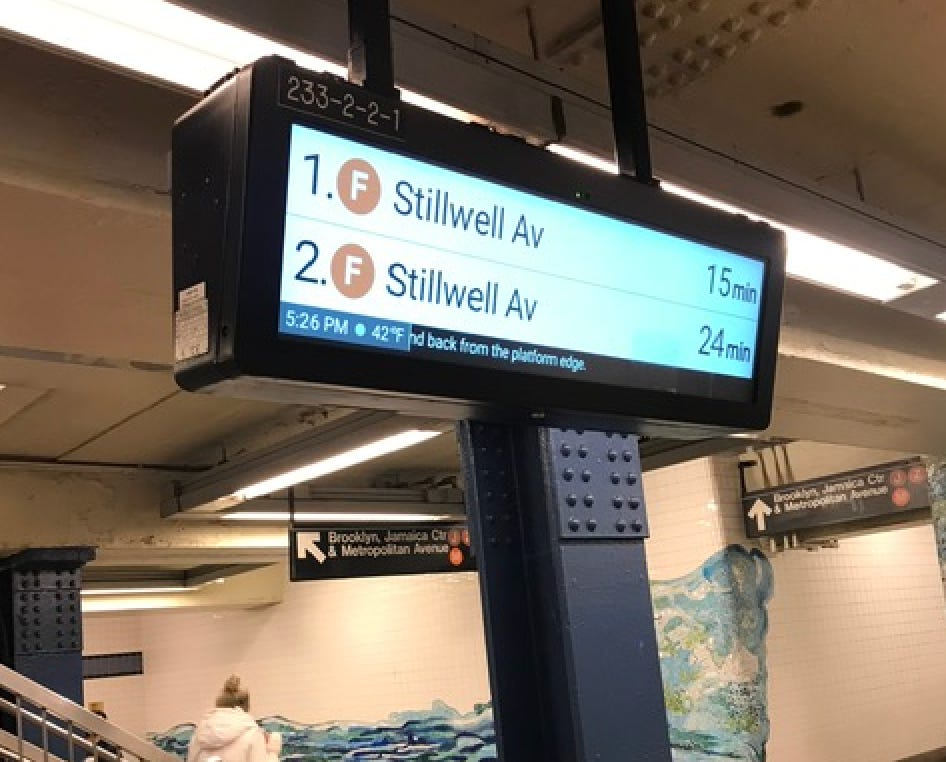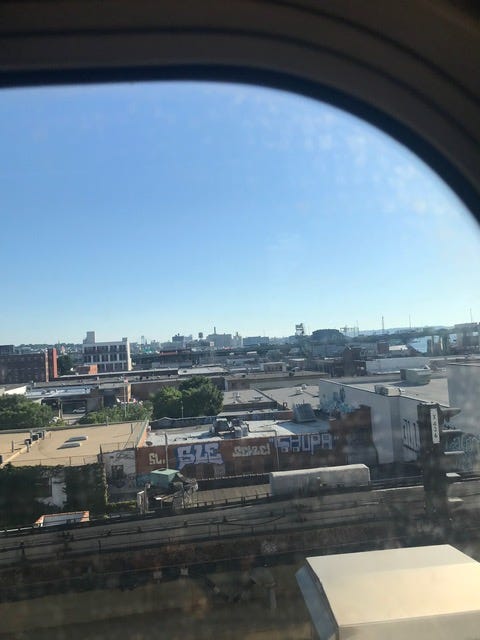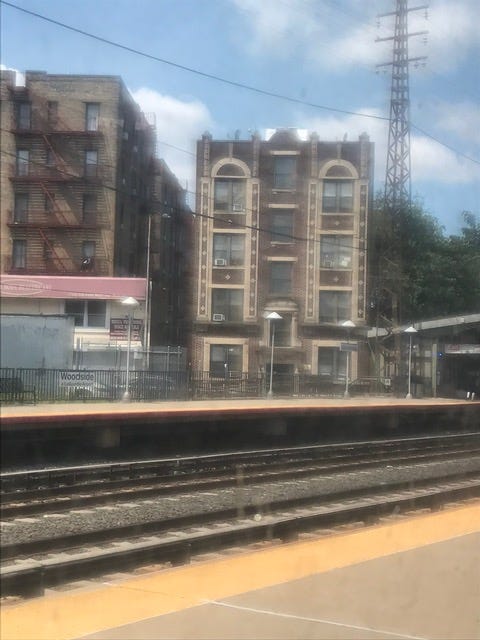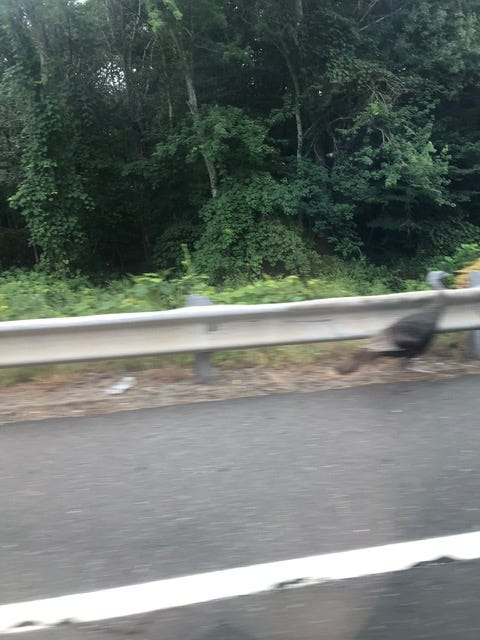Getting around
On time, money, and mobility in New York
You can tap a debit card to ride the subway now. It’s prompted some consternation on the left: it cost money to install the machines, which farm out our data to surveillance companies, and of course the subway should be free regardless. I’ll probably eat these words, but honestly, it’s nice. In the old days I was always missing trains when I had to put another twenty bucks on my MetroCard, jabbing a touchscreen caked in Mesozoic film (Add Value? Add Time?) as the F pulled away below. Even when the turnstile display flashed the dreaded INSUFFICIENT FARE, you’d be left with odd dollar amounts on your card, loose change cast at the throne of Andrew Cuomo. The MTA always comes out ahead.
I passed the fall reading Lucy Sante and Fran Lebowitz, plotting an essay for the since-shuttered New Gawker about the preservationist nostalgia that passes for progressive activism in New York. It’s frivolous, but Feral City’s argument — that Manhattan might belong to the people, should those people resemble Clinton Democrats — had me pissed. Jeremiah Moss believes he’s a Good New Yorker because he shops local and reads poetry; he believes COVID was a net positive, because it chased the hedge-funders and mommy-bloggers away to their summer homes. Where New York once catered to romantic transplants, today it caters to…different romantic transplants, ergo the staggering death toll (visited disproportionately upon poor and brown communities, but no matter) was karmic retribution.
It’s almost too stupid to engage with, but in the intervening months I’ve found myself thinking about the Good New Yorker. My current apartment is a half-dozen blocks from the tenement in which my grandparents grew up, but by any account my residence places me among the re-settlers gentrifying the Lower East Side. The question of who can afford New York City is not open to interpretation: two decades into a housing crisis, we debate who deserves to live here. I can’t make a claim for myself. Thanks to the assimilation lottery, I grew up along the New Haven Line; New York, the logic goes, ought be reserved for those who never had the mobility.
In western contexts, nativism is a function of “natives” (who tend not to be actual natives) menacing powerless latecomers and minorities. New York is, as ever, exceptional. The city’s “natives” — American-born descendants of late-wave migrants who couldn’t participate in postwar white flight — are targets of urban renewal, displaced by outside capital. The case against gentrification is that no man should be driven from his home, an ethical no-brainer that, given insufficient housing stock, reinforces New York’s exclusivity. Together, developers and their ostensibly liberal opponents have realized a city that rejects the huddled masses while evicting its own.
The ideal of New York as packaged by real-estate magnates and center-left politicians still hinges on local flair, the persistence of immigrants, artists, and radicals. Every New Yorker has a sense of who belongs, as well as a sense of what’s missing. Positions are assumed by virtuous commoners, entitled transplants (those who ingratiate themselves within extant communities, or add something of their own), and interloping plunderers, each advancing his relative qualifications. Acceding to these terms — that a city must, by definition, exclude someone — is tantamount to giving the game away.
Still, guilt supposes a certain agency. I lived with four roommates, out of necessity, through my thirtieth birthday; I moved out, at great expense, when COVID made a threat of collective air. I spent the 2010s working long days for imperiled internet startups — whoever was hiring on LinkedIn — and watching my purchasing power shrink with each paycheck. This isn’t about the erosion of the middle class, it’s about what happens when costs of housing and living surge beyond any foreseeable income. What’s privilege when you can’t afford groceries?
I was reminded, throughout my childhood, how much I owe to a filing error. Grandpa was supposed to join some doomed platoon in the European theatre, but the Navy lost his paperwork between a drawer and the wall. The mission had been thwarted by the time they found his papers, so he was sent to patrol the Atlantic from a base in Florida instead. He wound up back in the tenements, but only briefly — he went to college on the G.I. Bill, by which time tract houses were sprouting up across unexplored Queens. In spite of the Nazis and the Depression, an earthly reward lay just down Jamaica Avenue. Whattatown!
Survivor’s remorse isn’t the term; if you’re breathing, you’re a statistical anomaly. Assimilation is a function of looking and acting the part, and as with gentrification, it’s often a process of punching down. Sometimes I’m spooked by how badly I want to buy into the Ellis Island progress narrative. To say New York is the least bad place in America is a hollow distinction: if my trans-Atlantic forebears were enticed by abundant labor opportunities, they might’ve guessed there’d be no safety net.
Most of the world envisions New York as a decadent backwater, while the heartland imagines a socialist sex dungeon straddling the Hudson and East Rivers. A country founded on personal liberty is impervious to shame, but the Good New Yorker occupies very little space. He circulates on foot, travels lightly, and minimizes his carbon footprint. He respects what remains of local culture; he donates to the library and the park conservancy. If humans were to survive as a species, America would need to look a lot more like New York.
Asceticism becomes second nature when the median rent is $4,200. Over a decade in Manhattan, I’ve never once called an Uber or ordered food delivery — not because they’re indulgent, but because they’re expensive. As an able-bodied man, I can’t speak for all of my neighbors. But what do you think you’re paying for? My understanding was, it’s access to amenities — a subway, a takeout place in stumbling distance — you wouldn’t be able to enjoy elsewhere.
Then 50,000 New Yorkers dropped dead of an airborne virus. Cars, I think, make America irredeemable, right up there with guns and non-representative democracy. But after three years of trying and hoping for the best, I realized I couldn’t visit vulnerable people if it meant spending hours on MTA trains packed with unmasked yokels. I began trawling Craigslist for a cheap car to park on the street, and on a Friday in January I rode the D up to 183rd to see about a 2009 Pontiac Vibe.
Things were a little off from jump. The Craigslist ad sent me to a dealer on Third Avenue, but when I got there and called the number, it turned out the car was in another lot fifteen blocks away. When I reached the second location — an unpaved expanse bound by barbed wire, packed with Camrys and Jettas in varying states of disrepair — a dozen West African guys piled out of a trailer. The one I’d spoken to on the phone led me to the Vibe and tossed me the keys. It was clearly a different car than the one in the ad, and the odometer had 60,000 miles more than advertised. But I’d taken the train all the way there, and the ignition turned over, so I said I’d take it out onto the Cross Bronx.
The manual transmission shifted nicely, and I managed to push it into fifth in the rush hour traffic. Everything seemed fine until I slowed into the Tremont Avenue exit and the entire chassis starting bucking like a rodeo animal. “Looks like something’s wrong with the brakes,” the sales guy, riding shotgun, said. He said he couldn’t have known, he just bought cars at auction, and maybe I’m a sap but I kind of believed him. Luckily for me, he knew a mechanic on 187th — the best in the city — who could take a look.
This was becoming a whole thing; I wasn’t sure I could back out. The scowling mechanic threw the Vibe on a lift, exposing a rusted-out undercarriage held together with baling wire. He pointed to one of the rear brakes, which was frozen to the axle. I asked how much it would cost to fix. “For you?” the mechanic said, gnawing on a toothpick. “Five hundred.” The sales guy told me he couldn’t pay for the work without my making an offer on the car, at which point I walked back to the D train.
There’s this block across from Chelsea Waterside Park, right where 11th Avenue merges with the West Side Highway. The entire 23rd Street side’s been shrouded in construction scaffolding since I was in high school — we used to park over there sometimes when we’d drive in on weekends. Running down 23rd a few weeks ago, I was astonished to find the scaffolding gone. It was disorienting; I’ve never known New York without it. The ground floor of the finally-completed residential building has full-length windows glimpsing into a fancy gym. There’s never anybody in it.
Remember seasons? Part of it, I think, is an adulthood thing: I’m not outside waiting for the school bus at the asscrack of dawn anymore. It’s also a New York thing. My first two rooms in Manhattan didn’t have windows, which is illegal, but demand trumps enforcement. My current bedroom has east-facing windows which light up half the apartment for a few hours each day, but from inside you wouldn’t know February from September. Whatever — they hiked the rent again and I won’t be staying much longer.
A few days after striking out with the Vibe, I rode the 7 out to Woodside and bought a 2008 Civic coupe. I’ve got a few gripes: it’s the “Sport Injected” trim, which gets subpar mileage; it only takes high-octane fuel, and the six-speed manual is annoying in traffic. (If I were trying to be Pete Toretto, I wouldn’t drive a Civic.) Otherwise, knock on wood, it’s doing the job. I expected alternate-side parking to ruin my life, but my s/o lives in a Brooklyn neighborhood with once-a-week street cleaning, so I only move it every couple of days.
What threw me for a loop was the insurance. I’d gotten a few anonymous quotes before making the offer, but as an unwed male without property or insurance history, I wound up in the high-risk pool. Allstate, Esurance, Farmers, Liberty Mutual, Nationwide, and State Farm straight up do not insure drivers with Manhattan zip codes; Geico quoted me $700 a month, a twelve-month policy carrying a higher price tag than the car itself. After settling on a bare-bones package from Progressive, I’m making peace with the fact that — after eleven years in the workforce — a sixteen-year-old Civic could still break me.
My spidey sense tells me my earning potential has an expiration date, the proverbial Vibe with busted brakes depreciating in a trash-strewn lot. There’s a limitless supply of college grads with bright smiles and good metabolism eager to plow through spreadsheets — I get older, they stay the same age, etc. — and I’ve only been in a few workplaces where anybody was older than 35 or so. I worry once we hit 40 there’ll be nothing to do besides delivering DoorDash.
When I moved into my apartment in 2020, it was the cheapest market-rate unit listed in a five-mile radius. It still is, it just costs 65% more now. I’m not sure if this is being ignored or it’s somehow skirting awareness, and I’m not sure which is worse: not one but two Democrats running for mayor thought the median home in Brooklyn cost $100,000. Based on the 40x rule, you can’t get approved for any apartment with an income much below that threshold. NYCHA hasn’t added any housing in my lifetime; rent control and the co-op movement are dead.
On January 1, 2022, I caved into whatever inflation fear-mongering I’d been reading and opened an E-Trade account, moving two-thirds of my savings into low-risk index funds which promptly lost a quarter of their value. They haven’t recovered, and it doesn’t matter. Any mundane event — a layoff, a child, an F-150 roaring through a red light — would undo a decade of painstaking thrift. What’s a few grand in either direction?
Most of my friends couldn’t find work when we finished college in 2012, so I felt lucky to land a full-time “fellowship” with a large magazine in D.C. — an arrangement since ruled illegal in a court of law — that paid $11 an hour without benefits. Many of my classmates had drifted into pre-professional, practical-sounding degree programs in hopes of making good on their investment. Then we sat down with counselors at the career center, who advised us to accept literally any job offer that came our way. The ACA was already two years old; we could’ve stayed on our parents’ insurance through age 26, which I did in spite of steadyish employment.
I rented a place with a childhood friend clinging to undergraduate enrollment at GW. The hallway had waxy wallpaper like in a hotel; this memory causes me to wince. After moving in — my first apartment! — I trotted up and down our floor knocking on doors to introduce myself. Christ, I might’ve even baked cookies. Did I suppose our neighbors were any less transient than we? Did I plan to ingratiate myself into stable adulthood? A year later I got laid off, couldn’t find another job in D.C., and moved to New York where I’ve never met any of my neighbors.
On the phone, my father was warning me about Citi Bike — he’d read that cycling deaths were way up. Then we found another article that said pedestrian deaths are increasing. Turns out motorists are also dying at a higher rate than before. An ex-Marine murdered a man on the subway and the mayor and governor both said it was okay. Comings and goings about town.
New York is back, the island having ceded all sidewalks south of 14th to retail queues. Standing in a line with 500 people is the definitive downtown experience. Precious weekends are reserved for Supreme drops, vacuum-sealed weed, chicken sandwiches with the not-actually-all-that-spicy honey on them, Kith-branded churros. The Jordans with the inverted swooshes are marked up 90,000 percent; everything looks busted on purpose. 1.3 million dead, and as soon as the light turns green it’s back to this shit. How many clothes does a hybrid office job demand? Consumer culture is the only culture, but imagine falling for this crap.
Optimists are sustained by echoes. I loved listening to Hot 97 and Power 105 as a kid: the rush hour mixes, the manufactured rap beef, the local perversion of Big Four entertainment. I hadn’t been near a radio dial in fifteen years, but on street-cleaning days I’ve been toying with the FM scanner. Hot 97 and Power 105 are unlistenable, but WBLS and 94.7 The Block have a new format. Their playlists span roughly 1992 through 2006, just before New York radio was subsumed by Lil Wayne and generic national programming. (Per usual, we have Bill Clinton and Rudy Giuliani to thank.)
They’re really leaning into the bit. From the driver’s seat, I’ve encountered once-beloved DJs like Miss Jones and Cipha Sounds, exhumed to perform the exact jobs they did in 1999; it’s surreal to hear Ed Lover’s thoughts on Ron DeSantis. Of course, this isn’t a new format at all — I’m reached the oldies demo — but it’s nice company while moving my 2,800-pound fuel-burning pandemic purchase a quarter-mile at a time for no reason.







